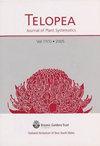Hiding in plain sight, Ficus desertorum (Moraceae), a new species of rock fig for Central Australia
IF 0.5
4区 生物学
Q4 PLANT SCIENCES
引用次数: 1
Abstract
A new species of lithophytic fig, Ficus desertorum B.C.Wilde & R.L.Barrett, endemic to arid Central Australia, is described and illustrated. It is distinguished from other species in Ficus section Malvanthera Corner by having stiff lanceolate, dark green, discolorous leaves; many parallel, often obscure lateral veins; petioles that are continuous with the midrib; with minute, usually white hairs and non- or slightly sunken intercostal regions on the lower surface. Previously included under broad concepts of either Ficus platypoda (Miq.) Miq. or Ficus brachypoda (Miq.) Miq., this species has a scattered distribution throughout Central Australia on rocky outcrops, jump-ups (mesas) and around waterholes. This culturally significant plant, colloquially referred to as the desert fig, grows on elevated landscapes in central Australia, including Uluru (Ayers Rock), Kata Tjuta (The Olgas) and Karlu Karlu (Devils Marbles), three of Central Australia’s best-known natural landmarks. Evidence is provided to show these plants are geographically and morphologically distinct from Ficus brachypoda, justifying the recognition of F. desertorum as a new species. Taxonomic issues with F. brachypoda and F. atricha D.J.Dixon are also discussed. Lectotypes are selected for Urostigma platypodum forma glabrior Miq. and Ficus platypoda var. minor Benth.藏在显眼地方的无花果(桑科),澳大利亚中部的一种新的岩无花果
描述和说明了一种新的岩生无花果,Ficus desertorum B.C.Wilde & R.L.Barrett,干旱的澳大利亚中部特有。它与榕科Malvanthera Corner的其他物种不同,具有坚硬的披针形,深绿色,变色的叶子;许多平行的,通常不明显的侧脉;与中脉连续的叶柄;具有微小的,通常是白色的毛和在下部表面的非或稍下陷的肋间区域。以前包括在广义概念下的榕(Miq.)进行筛选。或短足榕(Ficus brachypoda)进行筛选。这个物种分散分布在整个澳大利亚中部的岩石露头,跳跃(台地)和水坑周围。这种具有重要文化意义的植物,俗称沙漠无花果,生长在澳大利亚中部的高地上,包括乌鲁鲁(艾尔斯岩)、卡塔·朱塔(奥尔加斯)和卡尔鲁·卡尔鲁(魔鬼大理石),这是澳大利亚中部最著名的三个自然地标。这些植物在地理和形态上都与短足榕属植物不同,证明了荒漠榕属植物是一个新种。本文还讨论了短足藻和非洲藻的分类问题。选择了扁桃形尿柱头(Urostigma platypom forma glabrior Miq)的选育型。和小扁形榕。
本文章由计算机程序翻译,如有差异,请以英文原文为准。
求助全文
约1分钟内获得全文
求助全文
来源期刊

Telopea
PLANT SCIENCES-
CiteScore
1.30
自引率
42.90%
发文量
0
期刊介绍:
Manuscripts submitted for publication in TELOPEA are published online, after peer review and acceptance by the TELOPEA Editorial Committee and when final editorial formatting has been completed. The journal specialises in plant systematics and phylogeny. The geographic scope of the journal encompasses Australia, Malesia, Melanesia, Micronesia, and Polynesia. The suitability of a work for the journal depends on the topic and the region of origin, generally the narrower the focus of the manuscript the closer to New South Wales must be its geographic focus.
As a general guide, we will consider:
1) revisionary treatments and other substantial bodies of work from any of the regions mentioned above.
2) new species from any Australian state.
3) new country records for Australia from any state.
4) new state records from New South Wales only.
However, we aim to support botanical research across the broader Australasian and Pacific region, and will consider submissions on their merit.
Generally we will not consider extraterritorial new country records, or single lectotypification papers unless they pertain to New South Wales taxa, or have significant bearing on the Australian flora.
 求助内容:
求助内容: 应助结果提醒方式:
应助结果提醒方式:


